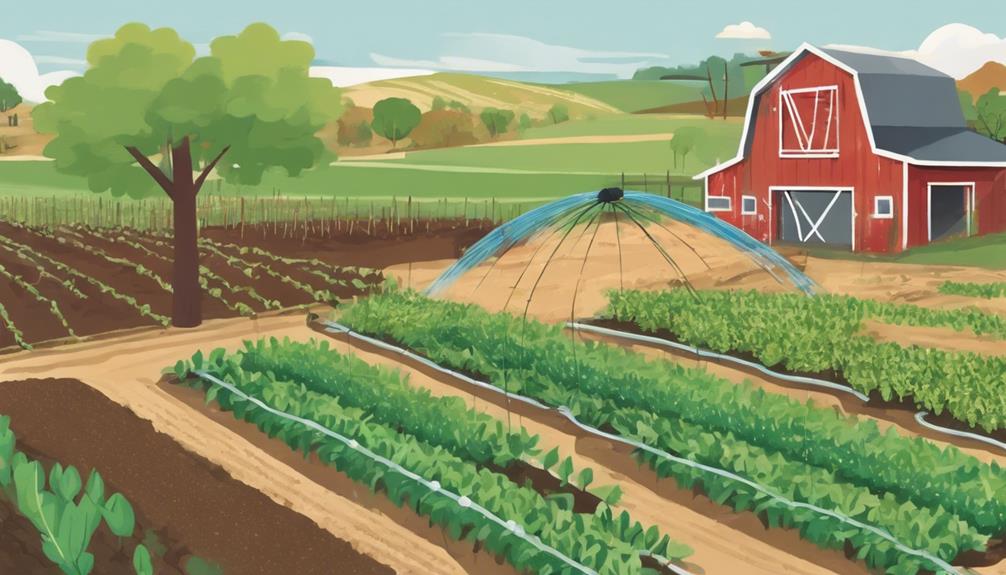7 Best Practices for Carbon Sequestration in Farming
To enhance carbon sequestration in farming, focus on soil health, cover crops, agroforestry, reduced tillage, composting, biodiversity, and efficient water management. Prioritize soil health to optimize carbon storage efficiency. Choose cover crops wisely to improve soil health and increase carbon sequestration potential. Integrate trees with crops through agroforestry for enhanced carbon storage and biodiversity. Reduce tillage practices to minimize soil disturbance and improve carbon storage. Embrace composting to enrich soil with carbon-friendly nutrients. Promote biodiversity within farming systems for increased resilience and carbon sequestration benefits. Optimize water management strategies for efficient crop yield and carbon conservation. Maximize your farm's carbon sequestration potential with these practices.
Soil Health for Carbon Sequestration
To enhance carbon sequestration in farming practices, prioritizing soil health is crucial for maximizing the efficiency of carbon storage and minimizing emissions. Regenerative agriculture, which focuses on restoring and enhancing soil health, plays a fundamental role in carbon sequestration efforts. One key aspect of regenerative agriculture is fostering diverse and thriving microbial communities in the soil.
Microbial communities, consisting of bacteria, fungi, protozoa, and other organisms, are essential for soil health and carbon sequestration. These microscopic organisms play a crucial role in nutrient cycling, soil structure formation, and organic matter decomposition. By promoting the growth and activity of beneficial microbes through regenerative practices such as reduced tillage, cover cropping, and crop rotation, farmers can enhance soil health and increase carbon sequestration potential.
Research has shown that regenerative agriculture practices lead to higher levels of soil organic matter, which is a key component of soil carbon. As organic matter decomposes, it releases carbon compounds that are stored in the soil, contributing to long-term carbon sequestration. Additionally, healthy soils with abundant microbial communities are more resilient to environmental stressors, such as drought and extreme weather events, further enhancing their capacity to store carbon.
Cover Crops Selection and Rotation
Selecting and rotating cover crops strategically is a critical practice in enhancing soil health and optimizing carbon sequestration potential in farming systems. Cover crops play a vital role in sequestering carbon through various mechanisms such as nitrogen fixation, which enhances soil fertility and reduces the need for synthetic fertilizers. Leguminous cover crops like clover and vetch are particularly beneficial for their ability to fix atmospheric nitrogen into the soil, promoting plant growth and carbon storage. Additionally, the root structure of cover crops helps in improving soil aggregation and stability, facilitating the storage of organic carbon.
Incorporating cover crops with dense and fibrous root systems also aids in weed suppression by outcompeting unwanted plant species for resources. This natural weed control minimizes the need for herbicides, contributing to a more sustainable farming approach. Moreover, the canopy formed by cover crops assists in moisture retention by reducing evaporation, enhancing water infiltration, and mitigating soil erosion. These factors collectively create a conducive environment for microbial activity, promoting organic matter decomposition and the sequestration of carbon in the soil.
Agroforestry and Silvopasture Integration
Incorporating agroforestry and silvopasture practices in your farming system can significantly enhance carbon sequestration and biodiversity while providing additional economic opportunities. By combining tree planting techniques with livestock integration, you can create a sustainable and multifunctional agricultural system that offers numerous benefits.
- Tree Planting Techniques: Utilize techniques such as alley cropping or windbreak planting to incorporate trees into your farming practices effectively. Selecting native tree species and planting them strategically can help sequester carbon, prevent soil erosion, and provide habitat for beneficial wildlife.
- Livestock Integration: Integrate livestock into agroforestry systems to maximize land use efficiency and diversify income streams. Grazing animals among trees in silvopasture systems can improve soil health, reduce the need for external inputs, and enhance overall farm productivity.
- Agroforestry Benefits and Pasture Management: Implementing agroforestry practices not only sequesters carbon but also improves water retention, enhances biodiversity, and increases resilience to climate change. Effective pasture management within these systems can further optimize nutrient cycling, minimize soil compaction, and promote overall ecosystem health.
Reduced Tillage and No-Till Practices
Utilize reduced tillage and no-till practices to enhance soil health and promote long-term carbon sequestration in your farming operations. These practices involve minimal disturbance to the soil, which can have significant benefits for carbon storage. By leaving crop residue on the soil surface, you can improve crop residue management, providing organic matter that enhances soil structure and promotes the activity of beneficial soil organisms. This, in turn, contributes to increased carbon sequestration potential.
In addition to improving soil health, reduced tillage and no-till practices offer other advantages. One key benefit is weed suppression, as reduced soil disturbance can help prevent weed seeds from germinating and spreading. This can reduce the need for herbicides, further promoting environmental sustainability on your farm. Moreover, these practices help with moisture retention in the soil. By maintaining more crop residue on the surface, you can reduce water evaporation, ensuring that your plants have an adequate water supply even during dry periods.
Composting for Soil Carbon Enrichment
To enhance soil health and maximize carbon sequestration potential on your farm, consider implementing composting practices for enriching soil carbon content. Composting is a valuable technique that can significantly improve soil quality and enhance carbon storage capacity. Here are three key reasons why composting is beneficial for promoting soil carbon enrichment:
- Microbial Diversity: Composting fosters a diverse community of beneficial microorganisms in the soil. These microbes play a crucial role in decomposing organic matter and releasing nutrients in forms that plants can readily absorb. By increasing microbial diversity through composting, you can enhance nutrient availability and promote overall soil health.
- Nutrient Cycling: Composting facilitates the efficient cycling of nutrients within the soil ecosystem. Organic materials added to the compost heap decompose over time, releasing essential nutrients such as nitrogen, phosphorus, and potassium. These nutrients are then incorporated into the soil, enriching its fertility and supporting plant growth. By effectively cycling nutrients through composting, you can reduce the reliance on external inputs and create a more sustainable farming system.
- Improved Soil Structure: Compost acts as a natural soil conditioner, improving soil structure and water retention capacity. The organic matter in compost helps to bind soil particles together, creating stable aggregates that enhance soil porosity and aeration. This improved soil structure allows for better root penetration, water infiltration, and overall plant growth. By incorporating compost into your farming practices, you can build healthier soils that are resilient to environmental stressors and supportive of long-term carbon sequestration efforts.
Biodiversity Promotion in Farming Systems
Enhancing biodiversity within your farming systems can significantly bolster ecosystem resilience and optimize agricultural productivity. One effective way to promote biodiversity is by creating pollinator habitats within your farm. Pollinators such as bees, butterflies, and birds play a crucial role in agricultural ecosystems by facilitating the reproduction of plants. By planting diverse flowering species and providing shelter, water, and nesting sites, you can attract and support these important pollinators, ultimately enhancing the overall biodiversity of your farm.
In addition to promoting pollinator habitats, enhancing agroecosystem resilience is another key aspect of biodiversity promotion in farming systems. A diverse range of plant species can help improve soil health, reduce the spread of pests and diseases, and increase crop yields. By planting a variety of crops, cover crops, and hedgerows, you can create a more resilient farming system that's better able to withstand environmental stresses and disturbances.
Research has shown that farms with higher levels of biodiversity tend to be more productive and sustainable in the long term. By incorporating practices that promote biodiversity, such as creating pollinator habitats and enhancing agroecosystem resilience, you can improve the overall health and productivity of your farm while also contributing to the conservation of important ecological resources.
Efficient Water Management Strategies

Efficient water management strategies play a vital role in optimizing agricultural productivity and resource sustainability on farms. Implementing techniques such as drip irrigation and rainwater harvesting can significantly enhance water efficiency, crop yield, and environmental conservation. Here are three key strategies for efficient water management on farms:
- Drip Irrigation: This precise watering method delivers small, steady amounts of water directly to the base of plants. By minimizing water loss through evaporation and runoff, drip irrigation ensures that plants receive an adequate supply of water while conserving this precious resource. Studies have shown that drip irrigation can increase crop yield by up to 30% compared to conventional watering techniques.
- Rainwater Harvesting: Capturing and storing rainwater for later use can reduce the reliance on groundwater and surface water sources. Farmers can collect rainwater from roofs, greenhouses, or specially designed catchment areas. This harvested water can then be used for irrigation, livestock, or even household purposes, offering a sustainable alternative to traditional water sources.
- Soil Moisture Monitoring: Utilizing technology to monitor soil moisture levels allows farmers to accurately determine when and how much water their crops need. By avoiding overwatering or underwatering, farmers can optimize water usage, prevent nutrient leaching, and promote healthier plant growth. Implementing soil moisture monitoring systems can lead to more efficient water management practices and improved overall farm productivity.
Conclusion
In conclusion, implementing the best practices for carbon sequestration in farming is crucial for promoting soil health, biodiversity, and sustainable water management.
By incorporating cover crops, agroforestry, reduced tillage, composting, and other strategies, farmers can effectively enhance carbon sequestration on their lands.
Research shows that these practices not only benefit the environment but also contribute to increased crop yields and overall farm resilience.
It's essential for farmers to prioritize these practices to mitigate climate change and ensure a sustainable future for agriculture.
